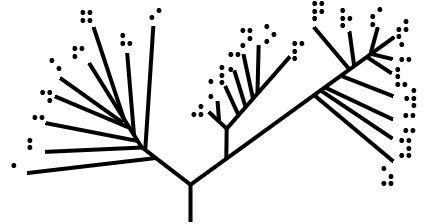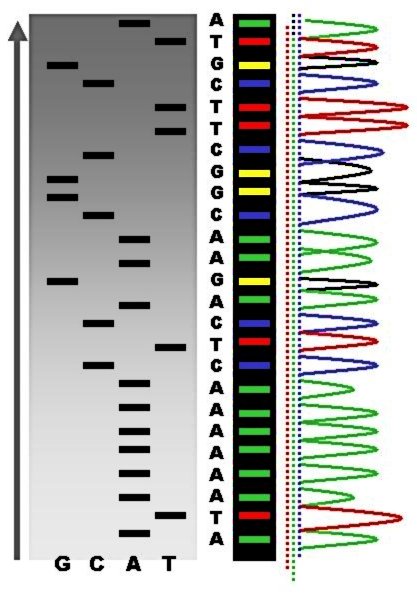|
Caminalcule
Caminalcules are a fictive group of animal-like life forms, which were created as a tool for better understanding phylogenetics in real organisms. They were created by Joseph H. Camin (University of Kansas) and consist of 29 living 'species' and 48 fossil forms. The name of the taxon Caminalcules seems to come from Camin's last name and Antonie van Leeuwenhoek's animalcules. History Joseph H. Camin (1922–1979) drew the Caminalcules in the early 1960s or possibly even earlier to study the nature of taxonomic judgement. He assured that there was genetic continuity in the Caminalcules by the preservation of all characters except for changes that he desired in all successive animals. He did not keep track of the changes he made in the different species. The images of the Caminalcules were made using master stencils. The images of the living OTUs (29 species) were made available in the early 1960s; those of the fossil ones (48 species) later in the decade. These images were copie ... [...More Info...] [...Related Items...] OR: [Wikipedia] [Google] [Baidu] |
Animalcule
Animalcule ('little animal', from Latin ''animal'' + the diminutive suffix ''-culum'') is an old term for microscopic organisms that included bacteria, protozoans, and very small animals. The word was invented by 17th-century Dutch scientist Antonie van Leeuwenhoek to refer to the microorganisms he observed in rainwater. Some better-known types of animalcule include: * '' Actinophrys'', and other heliozoa, termed sun animalcules. * ''Amoeba'', termed ''Proteus'' animalcules. * '' Noctiluca scintillans'', commonly termed the sea sparkles. * ''Paramecium'', termed slipper animalcules. * ''Rotifers'', termed wheel animalcules. * '' Stentor'', termed trumpet animalcules. * '' Vorticella'', and other peritrichs, termed bell animalcules. The concept seems to have been proposed at least as early as about 30 BC, as evidenced by this translation from Marcus Varro's ''Rerum Rusticarum Libri Tres'': Note also if there be any swampy ground, both for the reasons given above, and becau ... [...More Info...] [...Related Items...] OR: [Wikipedia] [Google] [Baidu] |
Phylogeny
A phylogenetic tree (also phylogeny or evolutionary tree Felsenstein J. (2004). ''Inferring Phylogenies'' Sinauer Associates: Sunderland, MA.) is a branching diagram or a tree showing the evolutionary relationships among various biological species or other entities based upon similarities and differences in their physical or genetic characteristics. All life on Earth is part of a single phylogenetic tree, indicating common ancestry. In a ''rooted'' phylogenetic tree, each node with descendants represents the inferred most recent common ancestor of those descendants, and the edge lengths in some trees may be interpreted as time estimates. Each node is called a taxonomic unit. Internal nodes are generally called hypothetical taxonomic units, as they cannot be directly observed. Trees are useful in fields of biology such as bioinformatics, systematics, and phylogenetics. ''Unrooted'' trees illustrate only the relatedness of the leaf nodes and do not require the ancestral root ... [...More Info...] [...Related Items...] OR: [Wikipedia] [Google] [Baidu] |
Convergent Evolution
Convergent evolution is the independent evolution of similar features in species of different periods or epochs in time. Convergent evolution creates analogous structures that have similar form or function but were not present in the last common ancestor of those groups. The cladistic term for the same phenomenon is homoplasy. The recurrent evolution of flight is a classic example, as flying insects, birds, pterosaurs, and bats have independently evolved the useful capacity of flight. Functionally similar features that have arisen through convergent evolution are ''analogous'', whereas ''homologous'' structures or traits have a common origin but can have dissimilar functions. Bird, bat, and pterosaur wings are analogous structures, but their forelimbs are homologous, sharing an ancestral state despite serving different functions. The opposite of convergence is divergent evolution, where related species evolve different traits. Convergent evolution is similar to paralle ... [...More Info...] [...Related Items...] OR: [Wikipedia] [Google] [Baidu] |
Maximum Parsimony (phylogenetics)
In phylogenetics, maximum parsimony is an optimality criterion under which the phylogenetic tree that minimizes the total number of character-state changes (or miminizes the cost of differentially weighted character-state changes) is preferred. Under the maximum-parsimony criterion, the optimal tree will minimize the amount of homoplasy (i.e., convergent evolution, parallel evolution, and evolutionary reversals). In other words, under this criterion, the shortest possible tree that explains the data is considered best. Some of the basic ideas behind maximum parsimony were presented by James S. Farris in 1970 and Walter M. Fitch in 1971. Maximum parsimony is an intuitive and simple criterion, and it is popular for this reason. However, although it is easy to ''score'' a phylogenetic tree (by counting the number of character-state changes), there is no algorithm to quickly ''generate'' the most-parsimonious tree. Instead, the most-parsimonious tree must be sought in "tree s ... [...More Info...] [...Related Items...] OR: [Wikipedia] [Google] [Baidu] |
Evolution
Evolution is change in the heritable characteristics of biological populations over successive generations. These characteristics are the expressions of genes, which are passed on from parent to offspring during reproduction. Variation tends to exist within any given population as a result of genetic mutation and recombination. Evolution occurs when evolutionary processes such as natural selection (including sexual selection) and genetic drift act on this variation, resulting in certain characteristics becoming more common or more rare within a population. The evolutionary pressures that determine whether a characteristic is common or rare within a population constantly change, resulting in a change in heritable characteristics arising over successive generations. It is this process of evolution that has given rise to biodiversity at every level of biological organisation, including the levels of species, individual organisms, and molecules. The theory of evol ... [...More Info...] [...Related Items...] OR: [Wikipedia] [Google] [Baidu] |
Taxonomic Diversity
Species diversity is the number of different species that are represented in a given community (a dataset). The effective number of species refers to the number of equally abundant species needed to obtain the same mean proportional species abundance as that observed in the dataset of interest (where all species may not be equally abundant). Meanings of species diversity may include species richness, taxonomic or phylogenetic diversity, and/or species evenness. Species richness is a simple count of species. Taxonomic or phylogenetic diversity is the genetic relationship between different groups of species. Species evenness quantifies how equal the abundances of the species are.Hill, M. O. (1973) Diversity and evenness: a unifying notation and its consequences. Ecology, 54, 427–432Tuomisto, H. (2010) A diversity of beta diversities: straightening up a concept gone awry. Part 1. Defining beta diversity as a function of alpha and gamma diversity. Ecography, 33, 2-22. Tuomisto, H. 20 ... [...More Info...] [...Related Items...] OR: [Wikipedia] [Google] [Baidu] |
Parallelism (biology)
Parallel evolution is the similar development of a trait in distinct species that are not closely related, but share a similar original trait in response to similar evolutionary pressure.Zhang, J. and Kumar, S. 1997Detection of convergent and parallel evolution at the amino acid sequence level. ''Mol. Biol. Evol.'' 14, 527-36. Parallel vs. convergent evolution Given a particular trait that occurs in each of two lineages descended from a specified ancestor, it is possible in theory to define parallel and convergent evolutionary trends strictly, and distinguish them clearly from one another. However the criteria for defining convergent as opposed to parallel evolution often are unclear in practice, so that arbitrary diagnosis is common in some cases. When two species are similar in a particular character, evolution is defined as parallel if the ancestors shared that similarity; if they did not, the evolution of that character in those species is defined as convergent. However, thi ... [...More Info...] [...Related Items...] OR: [Wikipedia] [Google] [Baidu] |
Homoplasy
Homoplasy, in biology and phylogenetics, is the term used to describe a feature that has been gained or lost independently in separate lineages over the course of evolution. This is different from homology, which is the term used to characterize the similarity of features that can be parsimoniously explained by common ancestry. Homoplasy can arise from both similar selection pressures acting on adapting species, and the effects of genetic drift. Most often, homoplasy is viewed as a similarity in morphological characters. However, homoplasy may also appear in other character types, such as similarity in the genetic sequence, life cycle types or even behavioral traits. Etymology The term homoplasy was first used by Ray Lankester in 1870. The corresponding adjective is either ''homoplasic'' or ''homoplastic''. It is derived from the two Ancient Greek words (), meaning "similar, alike, the same", and (), meaning "to shape, to mold". Parallelism and convergence Parallel a ... [...More Info...] [...Related Items...] OR: [Wikipedia] [Google] [Baidu] |
Rate Of Evolution
The rate of evolution is quantified as the speed of genetic or morphological change in a lineage over a period of time. The speed at which a molecular entity (such as a protein, gene, etc.) evolves is of considerable interest in evolutionary biology since determining the evolutionary rate is the first step in characterizing its evolution. Calculating rates of evolutionary change is also useful when studying phenotypic changes in phylogenetic comparative biology. In either case, it can be beneficial to consider and compare both genomic (such as DNA sequence) data and paleontological (such as fossil record) data, especially in regards to estimating the timing of divergence events and establishing geological time scales. At the organism level In his extensive study of evolution and paleontology, George Gaylord Simpson established evolutionary rates by using the fossil record to count the number of successive genera that occurred within a lineage during a given time period. For exampl ... [...More Info...] [...Related Items...] OR: [Wikipedia] [Google] [Baidu] |
Morphology (biology)
Morphology is a branch of biology dealing with the study of the form and structure of organisms and their specific structural features. This includes aspects of the outward appearance ( shape, structure, colour, pattern, size), i.e. external morphology (or eidonomy), as well as the form and structure of the internal parts like bones and organs, i.e. internal morphology (or anatomy). This is in contrast to physiology, which deals primarily with function. Morphology is a branch of life science dealing with the study of gross structure of an organism or taxon and its component parts. History The etymology of the word "morphology" is from the Ancient Greek (), meaning "form", and (), meaning "word, study, research". While the concept of form in biology, opposed to function, dates back to Aristotle (see Aristotle's biology), the field of morphology was developed by Johann Wolfgang von Goethe (1790) and independently by the German anatomist and physiologist Karl Fr ... [...More Info...] [...Related Items...] OR: [Wikipedia] [Google] [Baidu] |
DNA Sequencing
DNA sequencing is the process of determining the nucleic acid sequence – the order of nucleotides in DNA. It includes any method or technology that is used to determine the order of the four bases: adenine, guanine, cytosine, and thymine. The advent of rapid DNA sequencing methods has greatly accelerated biological and medical research and discovery. Knowledge of DNA sequences has become indispensable for basic biological research, DNA Genographic Projects and in numerous applied fields such as medical diagnosis, biotechnology, forensic biology, virology and biological systematics. Comparing healthy and mutated DNA sequences can diagnose different diseases including various cancers, characterize antibody repertoire, and can be used to guide patient treatment. Having a quick way to sequence DNA allows for faster and more individualized medical care to be administered, and for more organisms to be identified and cataloged. The rapid speed of sequencing attained with m ... [...More Info...] [...Related Items...] OR: [Wikipedia] [Google] [Baidu] |




